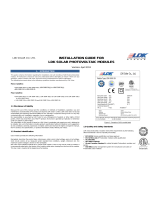
JA Solar PV Single-glass Modules Installation Manual Q/JASO-PMO-012 A/19
tools and electrically insulated gloves when working with Modules in sunlight.
Modules have no on/off switch. Modules can be rendered inoperative only by removing them from
sunlight, or by fully covering their front surface with cloth, cardboard, or other completely opaque material,
or by working with Modules face down on a smooth, flat surface.
In order to avoid arcs and electrical shock, please do not disconnect electrical connections under load.
Faulty connections can also result in arcs and electrical shock. So please keep connectors dry and clean, and
ensure that they are in proper working condition. Never insert metal objects into the connector, or modify them
in any way in order to secure an electrical connection.
Also in order to avoid the sand or water vapor entering which may cause a safety issue with the
connection, the modules need to be installed and connected to the combiner box once they are taken out from
the carton box, keep the connectors dry and clean during the installation, if the modules are not be installed
within a week, rubber connector covers shall be added as a protective measure. Note that pollution from sand,
dust and water will result in arcs and electrical shock of connectors. We suggest the customers add rubber
connector covers as a protection method specific to the area with heavy dust or seaside areas with higher
salinity or serious polluted areas
Reflection from snow or water can increase sunlight and therefore boost current and power. In addition,
colder temperatures can substantially increase voltage and power.
If the glass or other material is damaged, please wear personal protection equipment and separate the
module from the circuit.
Work only under dry conditions, and use only dry tools. Do not handle Modules when they are wet unless
wearing appropriate protective equipment. If you need to clean the Modules, please follow the cleaning
requirements mentioned in the manual.
Installation must be carried out under the guidance of a qualified electrician.
No matter how weather condition is, personnel entering the power station shall wear safety helmet,
insulating gloves and insulating shoes correctly, taking self-safety protection measures.
3.4 Operating Safety
Do not open the package of JA Solar Modules during transportation and storing until they are ready to be
installed.
At the same time please protect the package against exposure to damage. Secure pallets from falling over.
Do not exceed the maximum height of pallets to be stacked, as indicated on the pallet packaging.
Store pallets in a ventilated, rain-proof and dry location until the Modules are ready to be unpacked.
Please unpack the package of JA Solar Modules according to “JA Solar Modules Un-Pack Instruction”.
Do not lift the Modules by grasping the Module’s junction box or electrical leads in any condition.
Do not stand or step on the Modules.
Do not drop the Modules on another Module.
Do not place any heavy objects on the Modules to avoid glass breakage.
Be cautious when setting the Modules down on to a surface, especially on the corner of the Modules.
Inappropriate transport and installation may break the Modules.
Do not attempt to disassemble the Modules, and do not remove any attached nameplates or components
























